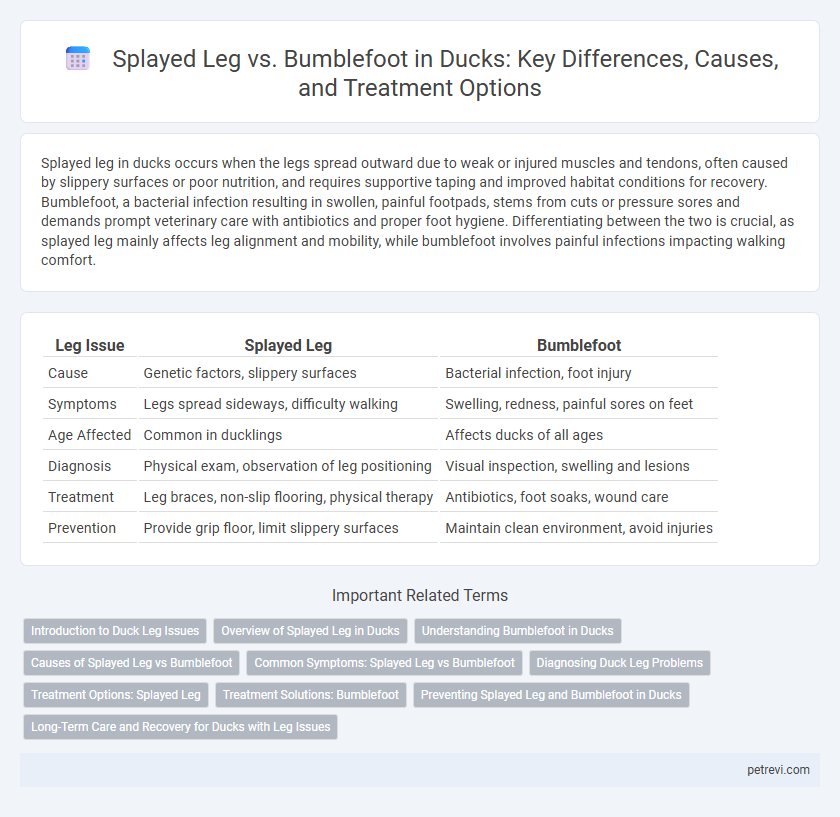Splayed leg in ducks occurs when the legs spread outward due to weak or injured muscles and tendons, often caused by slippery surfaces or poor nutrition, and requires supportive taping and improved habitat conditions for recovery. Bumblefoot, a bacterial infection resulting in swollen, painful footpads, stems from cuts or pressure sores and demands prompt veterinary care with antibiotics and proper foot hygiene. Differentiating between the two is crucial, as splayed leg mainly affects leg alignment and mobility, while bumblefoot involves painful infections impacting walking comfort.
Table of Comparison
| Leg Issue | Splayed Leg | Bumblefoot |
|---|---|---|
| Cause | Genetic factors, slippery surfaces | Bacterial infection, foot injury |
| Symptoms | Legs spread sideways, difficulty walking | Swelling, redness, painful sores on feet |
| Age Affected | Common in ducklings | Affects ducks of all ages |
| Diagnosis | Physical exam, observation of leg positioning | Visual inspection, swelling and lesions |
| Treatment | Leg braces, non-slip flooring, physical therapy | Antibiotics, foot soaks, wound care |
| Prevention | Provide grip floor, limit slippery surfaces | Maintain clean environment, avoid injuries |
Introduction to Duck Leg Issues
Duck leg issues commonly manifest as splayed leg and bumblefoot, both affecting mobility and overall health. Splayed leg, or spraddle leg, occurs when a duckling's legs spread sideways, often due to slippery surfaces or genetic factors. Bumblefoot is a bacterial infection causing swelling and lesions on the footpad, usually linked to poor sanitation or injury.
Overview of Splayed Leg in Ducks
Splayed leg in ducks, also known as spraddle leg, is a condition where the legs spread out sideways instead of staying under the body, often caused by slippery surfaces or incubation issues. This condition impairs mobility and can lead to difficulty in walking and feeding if untreated. Early intervention with supportive measures such as hobbles or textured floor surfaces can significantly improve the duck's leg alignment and overall health.
Understanding Bumblefoot in Ducks
Bumblefoot in ducks is a bacterial infection of the footpad caused by Staphylococcus aureus, often resulting from poor hygiene or rough surfaces. It presents as swelling, redness, and painful abscesses, which can lead to lameness if untreated. Proper treatment involves cleaning wounds, applying antibiotics, and improving habitat conditions to prevent recurrence.
Causes of Splayed Leg vs Bumblefoot
Splayed leg in ducks is primarily caused by genetic defects, slippery nesting surfaces, or nutritional deficiencies, leading to improper leg alignment and muscle weakness. Bumblefoot, on the other hand, results from bacterial infections, often due to cuts or abrasions on the duck's foot pad caused by rough or unsanitary living conditions. Understanding these distinct causes enables targeted prevention and treatment strategies for optimal duck leg health.
Common Symptoms: Splayed Leg vs Bumblefoot
Common symptoms of splayed leg in ducks include an inability to hold the legs under the body, resulting in legs that spread out to the sides, difficulty walking, and instability when standing. Bumblefoot symptoms present as swollen, red, or infected footpads, often with visible sores or scabs that cause limping or reluctance to bear weight on the affected leg. Both conditions impair mobility, but splayed leg primarily affects leg positioning while bumblefoot centers around painful foot infections.
Diagnosing Duck Leg Problems
Diagnosing duck leg problems involves distinguishing between splayed leg and bumblefoot by examining the symptoms and physical signs. Splayed leg typically presents as outward spreading of the legs, often caused by slippery surfaces or genetic factors, while bumblefoot manifests as swollen, inflamed footpads with possible sores or abscesses, resulting from bacterial infections. Accurate diagnosis requires close inspection of leg alignment, mobility, and foot condition to inform appropriate treatment strategies.
Treatment Options: Splayed Leg
Splayed leg in ducks requires immediate intervention through physical support such as hobbling to bring the legs together, allowing proper alignment during growth. Treatment also includes soft bedding to prevent further slipping and gentle exercises to strengthen the leg muscles. Early and consistent care significantly improves recovery outcomes and prevents long-term mobility issues.
Treatment Solutions: Bumblefoot
Bumblefoot in ducks requires prompt treatment involving thorough cleaning of the affected foot, soaking in antiseptic solutions, and applying antibiotic ointments to reduce infection. In severe cases, veterinary intervention with systemic antibiotics and possible surgical drainage improves healing outcomes. Regular monitoring and providing soft, dry bedding prevent recurrence and promote recovery from bumblefoot-related leg issues.
Preventing Splayed Leg and Bumblefoot in Ducks
Preventing splayed leg in ducks involves providing non-slip surfaces and ensuring proper nutrition rich in vitamins and minerals to support muscle and joint development. To avoid bumblefoot, it is essential to maintain clean, dry living environments with soft bedding to reduce foot injuries and regular inspection for early signs of infection. Consistent monitoring of duck leg health and prompt intervention significantly reduce the risk of these common leg issues.
Long-Term Care and Recovery for Ducks with Leg Issues
Splayed leg in ducks requires consistent splinting and soft bedding to ensure proper alignment and mobility during recovery, with early intervention critical for long-term success. Bumblefoot, a bacterial infection in the footpad, demands thorough cleaning, antibiotic treatment, and maintaining dry, clean living conditions to prevent recurrence. Both conditions necessitate ongoing monitoring and environmental adjustments to support healthy leg development and prevent future complications.
Splayed Leg vs Bumblefoot for Duck Leg Issues Infographic

 petrevi.com
petrevi.com